
Potato
Potato is the world’s 4th largest food crop following rice, wheat, and corn. Potatoes were first cultivated in Peru and Bolivia around 8,000 BC to 5,000 BC. The Inca Indians in Peru discovered a way to dehydrate and mash the potatoes, which they could store for a long time, and hence, potatoes became staple food in Peru.
In the mid-16th century, Spanish conquered Peru. They discovered the goodness of potatoes and carried them to Europe. Due its plain look and bland taste, people in Europe did not accept it as food and started using potatoes as livestock feed. However, the farmers in Europe found it easier to grow potatoes than other crops, hence potatoes became popular food crop there as well. Gradually, it spread around the world and has become staple food in many countries. Today, potato is grown in all 50 states in the USA and more than 125 countries throughout the world.
There are many varieties of potatoes categorized into starchy, waxy, and all-purpose types:
Starchy - Starchy potatoes are high in starch, low in moisture, and do not hold their shape well after cooking. Idaho Russet and Katahdin are examples of starchy potatoes. They are good for boiling, baking, and frying, but are not recommended for dishes like potato salads and casseroles which require firm-textured potatoes.
Waxy - Waxy potatoes are low in starch and are creamy and firm. They hold their shape after cooking. Red Bliss, Inca Gold, Fingerling, and New Potatoes are a few examples of waxy potatoes. This variety is excellent for cooking dishes that require firm potatoes, such as casseroles, potato salads, and gratin and can also be used for roasting, baking, boiling, and frying.
All-purpose - These potatoes are mild in starch; the starch content is more than waxy variety and less than starchy variety. All-purpose potatoes can be used for any cooking applications. Yukon gold and purple peruvian are examples of all-purpose potato.
Due to their mildly sweet taste, potatoes can be cooked in combination with other vegetables, meats, or spices to absorb their flavors and add impart its mild-sweetness to the dishes.
When buying, look for firm and clean potatoes with no discoloration, molds, or bruises. Store potatoes in a cool, dry, and ventilated place away from sunlight. The ideal temperature for storing potatoes is 50 degrees Fahrenheit or 10 degrees Celsius. An unheated basement or closet can be ideal for storing potatoes. At this temperature, potatoes will last for months. Storing potatoes at a temperature below 50 degrees Fahrenheit will convert its starch into sugar quickly, and you will end up with sweet tasting potatoes. On the other hand, higher temperature speeds up sprouting, water loss, and less firm potatoes. It’s recommended to buy less potatoes and use them quickly if you cannot store them at or around 50 degrees Fahrenheit.
Potatoes are gluten free, good source of carbohydrates, and are full of nutritional benefits needed for a healthy lifestyle. They are rich in minerals, such as potassium, iron, magnesium, calcium, and zinc, which help in building strong bones and maintaining a good blood pressure. They are also low in sodium and cholesterol and high in vitamin C and B6 that reduce inflammation and risk of heart disease. Fiber in potatoes promote a healthy digestive tract. Phytochemicals (antioxidants) along with vitamin C help prevent damage due to formation of free radicals.
In the mid-16th century, Spanish conquered Peru. They discovered the goodness of potatoes and carried them to Europe. Due its plain look and bland taste, people in Europe did not accept it as food and started using potatoes as livestock feed. However, the farmers in Europe found it easier to grow potatoes than other crops, hence potatoes became popular food crop there as well. Gradually, it spread around the world and has become staple food in many countries. Today, potato is grown in all 50 states in the USA and more than 125 countries throughout the world.
There are many varieties of potatoes categorized into starchy, waxy, and all-purpose types:
Starchy - Starchy potatoes are high in starch, low in moisture, and do not hold their shape well after cooking. Idaho Russet and Katahdin are examples of starchy potatoes. They are good for boiling, baking, and frying, but are not recommended for dishes like potato salads and casseroles which require firm-textured potatoes.
Waxy - Waxy potatoes are low in starch and are creamy and firm. They hold their shape after cooking. Red Bliss, Inca Gold, Fingerling, and New Potatoes are a few examples of waxy potatoes. This variety is excellent for cooking dishes that require firm potatoes, such as casseroles, potato salads, and gratin and can also be used for roasting, baking, boiling, and frying.
All-purpose - These potatoes are mild in starch; the starch content is more than waxy variety and less than starchy variety. All-purpose potatoes can be used for any cooking applications. Yukon gold and purple peruvian are examples of all-purpose potato.
Due to their mildly sweet taste, potatoes can be cooked in combination with other vegetables, meats, or spices to absorb their flavors and add impart its mild-sweetness to the dishes.
When buying, look for firm and clean potatoes with no discoloration, molds, or bruises. Store potatoes in a cool, dry, and ventilated place away from sunlight. The ideal temperature for storing potatoes is 50 degrees Fahrenheit or 10 degrees Celsius. An unheated basement or closet can be ideal for storing potatoes. At this temperature, potatoes will last for months. Storing potatoes at a temperature below 50 degrees Fahrenheit will convert its starch into sugar quickly, and you will end up with sweet tasting potatoes. On the other hand, higher temperature speeds up sprouting, water loss, and less firm potatoes. It’s recommended to buy less potatoes and use them quickly if you cannot store them at or around 50 degrees Fahrenheit.
Potatoes are gluten free, good source of carbohydrates, and are full of nutritional benefits needed for a healthy lifestyle. They are rich in minerals, such as potassium, iron, magnesium, calcium, and zinc, which help in building strong bones and maintaining a good blood pressure. They are also low in sodium and cholesterol and high in vitamin C and B6 that reduce inflammation and risk of heart disease. Fiber in potatoes promote a healthy digestive tract. Phytochemicals (antioxidants) along with vitamin C help prevent damage due to formation of free radicals.

Onion
Most researchers agree that onion has been cultivated for 5000 years or more, and they were first grown in central Asia. Others suggest that onions were first grown in Iran and western Pakistan. Onions can be grown in a variety of soils and climates and are less perishable; therefore, it is believed that they were domesticated simultaneously all over the world. It is interesting to know that Egyptians worshiped onions and believed that concentric rings of onions symbolize eternal life.
Due to pungent taste and smell, humans started onions to protect their plants from animals and insects. The strong flavor of onions comes from sulphur compounds, which onion plants absorb from soil when growing. When an onion is cut, certain enzyme breaks out producing strong sulphurous smell.
Cooking alters the strong and pungent taste of onions into meaty taste that adds flavor to various dishes in many cultures. Onions are also eaten in raw form to garnish many dishes. Cut onions can be rinsed properly to remove sulphur, when eaten raw. You can also put the onions in the freezer for 20-30 minutes to minimize the release of sulphurous smell and taste.
The sulphur compounds, flavonoids (antioxidants), and fructans (small carbohydrate molecules) help prevent cancer, stomach ulcer, and reduce symptoms of diabetes mellitus.
Whole dry onions should be stored at room temperature at dry place with proper ventilation. Do not store onions in closed plastic bags. Netted or punched bags are best to store whole onions for better ventilation, and last upto 4 weeks. Cut onions needs to be refrigerated. Cut onions stored in a sealed container can last up to a week.
Due to pungent taste and smell, humans started onions to protect their plants from animals and insects. The strong flavor of onions comes from sulphur compounds, which onion plants absorb from soil when growing. When an onion is cut, certain enzyme breaks out producing strong sulphurous smell.
Cooking alters the strong and pungent taste of onions into meaty taste that adds flavor to various dishes in many cultures. Onions are also eaten in raw form to garnish many dishes. Cut onions can be rinsed properly to remove sulphur, when eaten raw. You can also put the onions in the freezer for 20-30 minutes to minimize the release of sulphurous smell and taste.
The sulphur compounds, flavonoids (antioxidants), and fructans (small carbohydrate molecules) help prevent cancer, stomach ulcer, and reduce symptoms of diabetes mellitus.
Whole dry onions should be stored at room temperature at dry place with proper ventilation. Do not store onions in closed plastic bags. Netted or punched bags are best to store whole onions for better ventilation, and last upto 4 weeks. Cut onions needs to be refrigerated. Cut onions stored in a sealed container can last up to a week.
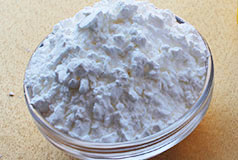
Rice Flour (Optional)
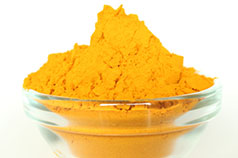
Turmeric Powder
Turmeric powder is a bright and deep yellow colored powder made by grinding dried underground stems of turmeric, which is starchy in nature. In India and some of its neighboring countries, turmeric in stem or powdered form has been used to color skin and clothing and to add color and aroma to food. It is also used as a pious powder during festivals and marriage ceremonies. In other parts of the world, turmeric is mainly used to add color and aroma to food. Turmeric has pungent and bitter taste but musky and mild fragrance.
Turmeric powder is made by steaming or boiling the underground stems in slightly alkaline water (measures above 7.0 on the pH scale) to precook the starch in turmeric. The alkaline water also improves the color of turmeric. Boiled turmeric stems are sun-dried and ground to make powder.
Turmeric powder is mainly used in curries, stir fried dishes, and dry rubs. It is also used in some spicy salad dressing and smoothies and drinks.
The compound called curcuminoids in turmeric is responsible for its yellow color and has antioxidant and preservative properties. Due to its antioxidant properties, use of turmeric in food helps prevent certain type of cancer, lowers cholesterol, lowers the risk of cardiovascular diseases, and protects from Alzheimer’s disease. Due to its preservative property, use of turmeric in food helps in extending the shelf-life of food.
Turmeric has also been used in Indian and Chinese system of medicine as an anti-inflammatory agent to treat various conditions such as toothache, bruises, chest pain, and digestion problems. In addition, turmeric contains very good amounts of minerals like iron, calcium, potassium, manganese, zinc, copper, and magnesium.
Store turmeric powder in a tightly sealed container in a cool, dark, and dry place. At room temperature, turmeric powder will taste fresh for 4 to 6 months. Refrigerate it for a longer shelf-life of up to 2 years.
Turmeric powder is available in Indian and South Asian grocery stores. Some of the popular brands of turmeric powder are Nirav, Deep, SWAD, Spicy World, and Jiva. You may also find it in supermarkets or gourmet markets. It is available at online grocery stores such as amazon.com, where you will be able to choose from several brands.
Turmeric powder is made by steaming or boiling the underground stems in slightly alkaline water (measures above 7.0 on the pH scale) to precook the starch in turmeric. The alkaline water also improves the color of turmeric. Boiled turmeric stems are sun-dried and ground to make powder.
Turmeric powder is mainly used in curries, stir fried dishes, and dry rubs. It is also used in some spicy salad dressing and smoothies and drinks.
The compound called curcuminoids in turmeric is responsible for its yellow color and has antioxidant and preservative properties. Due to its antioxidant properties, use of turmeric in food helps prevent certain type of cancer, lowers cholesterol, lowers the risk of cardiovascular diseases, and protects from Alzheimer’s disease. Due to its preservative property, use of turmeric in food helps in extending the shelf-life of food.
Turmeric has also been used in Indian and Chinese system of medicine as an anti-inflammatory agent to treat various conditions such as toothache, bruises, chest pain, and digestion problems. In addition, turmeric contains very good amounts of minerals like iron, calcium, potassium, manganese, zinc, copper, and magnesium.
Store turmeric powder in a tightly sealed container in a cool, dark, and dry place. At room temperature, turmeric powder will taste fresh for 4 to 6 months. Refrigerate it for a longer shelf-life of up to 2 years.
Turmeric powder is available in Indian and South Asian grocery stores. Some of the popular brands of turmeric powder are Nirav, Deep, SWAD, Spicy World, and Jiva. You may also find it in supermarkets or gourmet markets. It is available at online grocery stores such as amazon.com, where you will be able to choose from several brands.
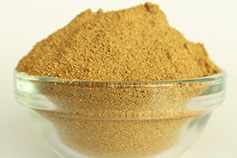
Coriander Powder
Coriander, also known as cilantro and Chinese parsley, is an herb native to Southeastern Europe and is cultivated in Egypt, Middle East, China, India, and Turkey. Coriander powder is made by grinding the dried or roasted seeds of coriander plant. The seeds are small (2-3 mm long), oval in shape, and light brown in color. Coriander powder provides mild-nutty flavor and aroma to many savory and sweet dishes.
Due to its mild-nutty taste and aroma, coriander powder is an essential ingredient in many vegetable and meat curry preparations and barbecue rubs and sauces. It is also added to waffle and pancake mixes and dessert sauces for an enhanced taste.
The presence of coriander powder in food stimulates the taste buds and helps digestion. Including coriander in your diet has many health benefits. It is a great source of potassium, iron, vitamin A, K and C, folic acid, magnesium, and calcium. It is a good source of antioxidants and helps detoxify the body.
Coriander powder is easily available in grocery stores or can be made at home by grinding the coriander seeds. To make coriander powder at home:
Due to its mild-nutty taste and aroma, coriander powder is an essential ingredient in many vegetable and meat curry preparations and barbecue rubs and sauces. It is also added to waffle and pancake mixes and dessert sauces for an enhanced taste.
The presence of coriander powder in food stimulates the taste buds and helps digestion. Including coriander in your diet has many health benefits. It is a great source of potassium, iron, vitamin A, K and C, folic acid, magnesium, and calcium. It is a good source of antioxidants and helps detoxify the body.
Coriander powder is easily available in grocery stores or can be made at home by grinding the coriander seeds. To make coriander powder at home:
- Either dry the coriander seeds in sun for a couple of days or slightly roast the seeds without oil in a pan. Roasting the seeds before grinding enhances the taste and aroma of the coriander powder. Also, drying in sun or roasting removes moisture from the seeds and adds crispness, which helps in powdering the seeds.
- Let the seeds cool and then grind them in a spice grinder. You can also use a coffee grinder for grinding spices; however it’s not recommended to use the same grinder for grinding spices and coffee.
- Store coriander powder in a tightly sealed container in a cool, dark, and dry place. If you are making coriander powder at home, cool it down before storing. It usually last for 4-6 months at room temperature. Refrigerate it for a longer shelf life of 18-24 months.
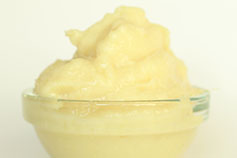
Ginger-Garlic Paste
Ginger-garlic paste is an important ingredient in Indian cooking. Most of the savory recipes in Indian cooking require ginger-garlic paste. You can either make the paste at home or buy it at an Indian or South Asian grocery store or gourmet markets.
The process of making ginger-garlic paste at home is very simple. All you need is peeled ginger and garlic in equal quantities and some olive oil (or any cooking oil of your choice).
To make 8 ounces (1 cup) of ginger-garlic paste, you’d need:
Ginger – 4 ounces (1/2 cup), peeled and cut into pieces
Garlic – 4 ounces (1/2 cup), peeled and cut into pieces
Olive oil – 1 tablespoon
Blend the ginger and garlic pieces with olive oil in a blender or a food processor. The oil will help ginger and garlic blend together. Store the paste in an airtight container and refrigerate it. It will stay fresh for 7-10 days.
In addition to enhancing the flavor and aroma of the food, ginger and garlic provide many health benefits if consumed on a regular basis. Both ginger and garlic have antioxidant and anti-inflammatory properties. Ginger has been proven to relieve a variety of ailments, such as gastrointestinal distress, motion sickness, arthritis, and cold and flu. Using garlic in food may help prevent many heart and blood system related conditions such as high blood pressure, high cholesterol, and coronary heart disease. Some researchers also claim that consumption of garlic on a regular basis reduces the risk of certain cancers such as stomach cancer, colon cancer, and lung cancer.
The process of making ginger-garlic paste at home is very simple. All you need is peeled ginger and garlic in equal quantities and some olive oil (or any cooking oil of your choice).
To make 8 ounces (1 cup) of ginger-garlic paste, you’d need:
Ginger – 4 ounces (1/2 cup), peeled and cut into pieces
Garlic – 4 ounces (1/2 cup), peeled and cut into pieces
Olive oil – 1 tablespoon
Blend the ginger and garlic pieces with olive oil in a blender or a food processor. The oil will help ginger and garlic blend together. Store the paste in an airtight container and refrigerate it. It will stay fresh for 7-10 days.
In addition to enhancing the flavor and aroma of the food, ginger and garlic provide many health benefits if consumed on a regular basis. Both ginger and garlic have antioxidant and anti-inflammatory properties. Ginger has been proven to relieve a variety of ailments, such as gastrointestinal distress, motion sickness, arthritis, and cold and flu. Using garlic in food may help prevent many heart and blood system related conditions such as high blood pressure, high cholesterol, and coronary heart disease. Some researchers also claim that consumption of garlic on a regular basis reduces the risk of certain cancers such as stomach cancer, colon cancer, and lung cancer.

Salt
Salt is a mineral composed of a chemical compound called sodium chloride. It is essential for human body to regulate fluid balance and to control function of nerves and muscles. Human body cannot produce its own salt and depends on various sources of salt in food for necessary daily intake.
In addition to being just a diet supplement, salt helps in extracting the real flavors of savory as well as sweet dishes. No other seasoning has been found so fulfilling to replace salt. However, the overuse of salt results into a lot of health problems, such as hypertension, heart disease, and strokes. Use salt mildly in your food to you can enjoy its goodness.
In addition to being just a diet supplement, salt helps in extracting the real flavors of savory as well as sweet dishes. No other seasoning has been found so fulfilling to replace salt. However, the overuse of salt results into a lot of health problems, such as hypertension, heart disease, and strokes. Use salt mildly in your food to you can enjoy its goodness.
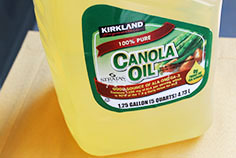
Canola Oil
Coming Soon...

Egg Plant
Coming Soon...
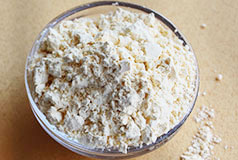
Gram Flour
Coming Soon...
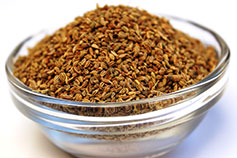
Carom Seeds
Coming Soon...
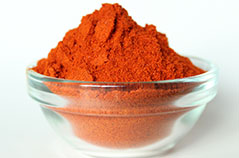
Red Chili Powder
Red chili powder is made by grinding dried deep red-brown thai chili peppers. Native to central and South America, red thai chili peppers were introduced to South Asia in 1500s and now India is the largest producer of these peppers in the world. Either in powdered or whole form, the chili peppers are used to add extra heat and spiciness to the dishes, which is due to the presence of a compound called capsaicin.
Red chili powder is a widely used spice for preparing a variety of curries, soups, stews, marinades, sauces, and dry rubs for barbecue. It is also used to flavor some sweet dishes such as cakes, brownies, truffles, and chocolates.
Red chili powder is a healthy seasoning. It contains significant amount of vitamin A and C, and beta carotenoids (a red-orange pigment that acts as an antioxidant and converts into vitamin A). It also helps to detoxify our body.
When purchasing red chili powder at store, look for the bright red colored powder for best taste. For making red chili powder at home:
Red chili powder is available in Indian and South Asian grocery stores. Some of the popular brands of red chili powder are Nirav, Deep, SWAD, Spicy World, and Everest. You may also find it in supermarkets or gourmet markets. It is available at online grocery stores such as amazon.com, where you will be able to choose from several brands.
Red chili powder is a widely used spice for preparing a variety of curries, soups, stews, marinades, sauces, and dry rubs for barbecue. It is also used to flavor some sweet dishes such as cakes, brownies, truffles, and chocolates.
Red chili powder is a healthy seasoning. It contains significant amount of vitamin A and C, and beta carotenoids (a red-orange pigment that acts as an antioxidant and converts into vitamin A). It also helps to detoxify our body.
When purchasing red chili powder at store, look for the bright red colored powder for best taste. For making red chili powder at home:
- Buy dry (not fresh) whole red thai chili peppers and remove the stems.
- Further dry the chili peppers in sun for a couple of days or slightly roast them for 2-3 minutes, without oil in a pan. Drying or roasting removes moisture from the chili peppers and adds extra crispness, which is required to powder them. Roasting the chili peppers enhances its flavor and aroma.
- Let the dried or roasted chili peppers cool down and then grind to a fine powder in a spice grinder. You can also use a coffee grinder for this purpose; however, the coffee grinder should be used for grinding spices only. It is not advisable to use the same grinder for spices and coffee.
Red chili powder is available in Indian and South Asian grocery stores. Some of the popular brands of red chili powder are Nirav, Deep, SWAD, Spicy World, and Everest. You may also find it in supermarkets or gourmet markets. It is available at online grocery stores such as amazon.com, where you will be able to choose from several brands.
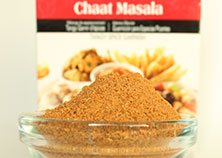
Chaat Masala
Chaat masala is a blend of certain spices that provides extra spiciness and tanginess to the savory dishes. It contains some basic spices found in every South Asian kitchen, such as coriander, cumin, and black pepper as well as some ingredients that are not commonly used, such as dried powdered mint, black salt, dried ginger powder, and dried mango powder. These spices, when blended together, create a distinctive flavor.
Chaat masala is very popular in the cuisines of India, Pakistan, and Bangladesh. It is used in a small quantity, along with other spices, to add more flavor to savory vegetarian dishes and marinades. You can sprinkle chaat masala on salad, lemonade, or even fruits for added zing.
You can buy kebab masala at Indian or South Asian grocery stores. The most popular brands of kebab masala are Shan, Everest, and MDH. It is also available at online grocery stores such as amazon.com.
Chaat masala is very popular in the cuisines of India, Pakistan, and Bangladesh. It is used in a small quantity, along with other spices, to add more flavor to savory vegetarian dishes and marinades. You can sprinkle chaat masala on salad, lemonade, or even fruits for added zing.
You can buy kebab masala at Indian or South Asian grocery stores. The most popular brands of kebab masala are Shan, Everest, and MDH. It is also available at online grocery stores such as amazon.com.
Chaat masala is a blend of certain spices that provides extra spiciness and tanginess to the savory dishes. It contains some basic spices found in every South Asian kitchen, such as coriander, cumin, and black pepper as well as some ingredients that are not commonly used, such as dried powdered mint, black salt, dried ginger powder, and dried mango powder. These spices, when blended together, create a distinctive flavor.
Chaat masala is very popular in the cuisines of India, Pakistan, and Bangladesh. It is used in a small quantity, along with other spices, to add more flavor to savory vegetarian dishes and marinades. You can sprinkle chaat masala on salad, lemonade, or even fruits for added zing.
You can buy kebab masala at Indian or South Asian grocery stores. The most popular brands of kebab masala are Shan, Everest, and MDH. It is also available at online grocery stores such as amazon.com.
Chaat masala is very popular in the cuisines of India, Pakistan, and Bangladesh. It is used in a small quantity, along with other spices, to add more flavor to savory vegetarian dishes and marinades. You can sprinkle chaat masala on salad, lemonade, or even fruits for added zing.
You can buy kebab masala at Indian or South Asian grocery stores. The most popular brands of kebab masala are Shan, Everest, and MDH. It is also available at online grocery stores such as amazon.com.
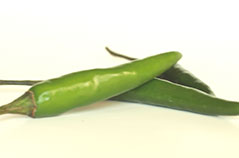
Thai Chili (Optional)
Thai chili pepper, also known as the Bird’s Eye or Bird pepper is one of the hottest chili peppers. It is small in size and high in heat and pungency. It is native to Mexico, Central America, and South America and is most commonly found in South Asia and Southeast Asia. It is a standard ingredient in South Asian and Southeast Asian cuisines and is used to add heat and spiciness to food.
In whole, chopped, or ground form, it is used to flavor curries, stews and soups, salads, hot sauces, marinades, rubs for barbecue, and seafood dishes. Chopped peppers with whole seeds add most heat and spiciness to the dishes, and it is a popular way of garnishing the savory dishes and salads in South Asian and Southeast Asian countries. To get mild spiciness and yet maintain the flavor and aroma of the chili peppers, completely remove the seeds and blanch the peppers.
Thai chili peppers ripen from green to orange and finally to bright red. The chili peppers at each stage are great for consumption and can also be used in combination. The mature red thai chili peppers are used in fresh as well as dried form. After harvesting, they are dried in sun for about 1 to 2 weeks, depending on the climate. They dry faster in climates with even sunlight and low moisture. Dried peppers have different flavor than fresh peppers and are chewy in texture. Dried red thai chili peppers are also ground to make red chili powder.
Thai chili peppers are sold in most of the supermarkets and Indian and South Asian grocery stores in the US. If not available, they can be replaced with serrano peppers. Store fresh thai chili peppers in a plastic bag, releasing as much air as possible, and refrigerate them. They will last for about 2 weeks in refrigerator. Store dried red thai chili peppers in a tightly closed jar in a dry and cool place, away from sunlight. They last for about a year if not in contact with moisture.
In whole, chopped, or ground form, it is used to flavor curries, stews and soups, salads, hot sauces, marinades, rubs for barbecue, and seafood dishes. Chopped peppers with whole seeds add most heat and spiciness to the dishes, and it is a popular way of garnishing the savory dishes and salads in South Asian and Southeast Asian countries. To get mild spiciness and yet maintain the flavor and aroma of the chili peppers, completely remove the seeds and blanch the peppers.
Thai chili peppers ripen from green to orange and finally to bright red. The chili peppers at each stage are great for consumption and can also be used in combination. The mature red thai chili peppers are used in fresh as well as dried form. After harvesting, they are dried in sun for about 1 to 2 weeks, depending on the climate. They dry faster in climates with even sunlight and low moisture. Dried peppers have different flavor than fresh peppers and are chewy in texture. Dried red thai chili peppers are also ground to make red chili powder.
Thai chili peppers are sold in most of the supermarkets and Indian and South Asian grocery stores in the US. If not available, they can be replaced with serrano peppers. Store fresh thai chili peppers in a plastic bag, releasing as much air as possible, and refrigerate them. They will last for about 2 weeks in refrigerator. Store dried red thai chili peppers in a tightly closed jar in a dry and cool place, away from sunlight. They last for about a year if not in contact with moisture.

Water
Coming Soon...
Share your thoughts and questions!


